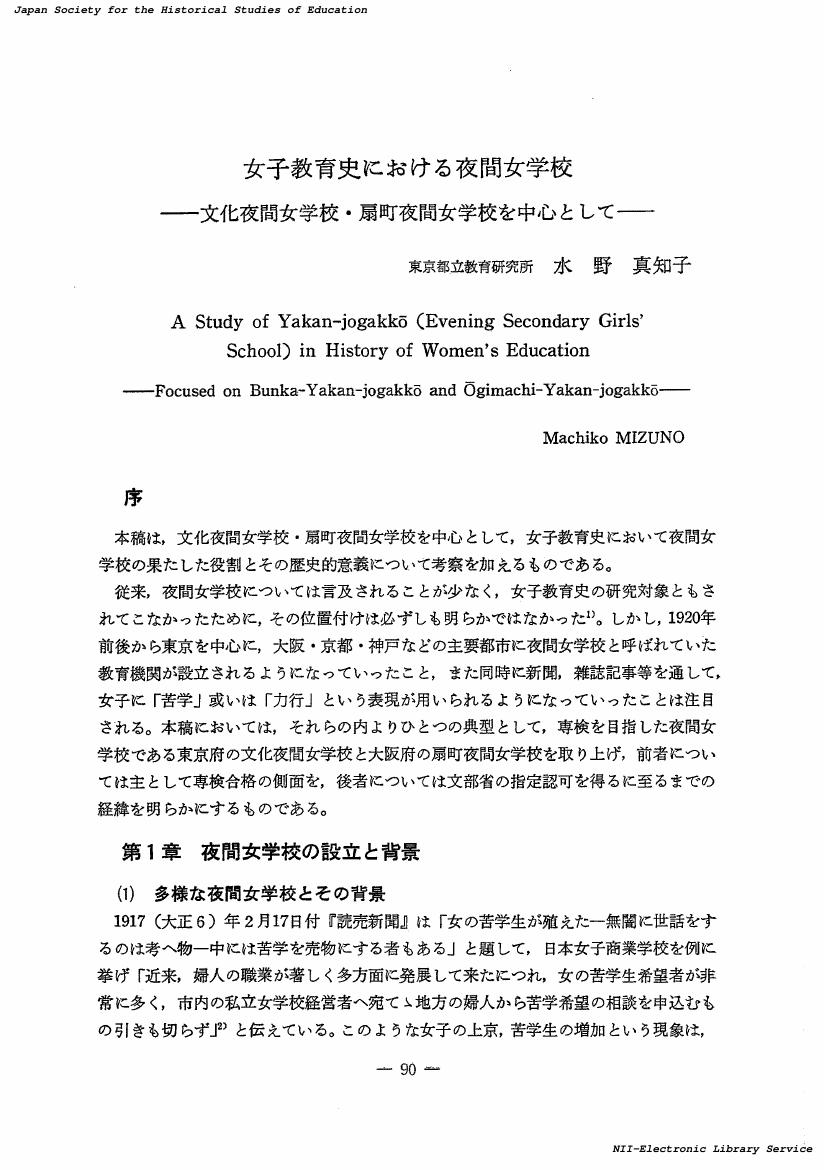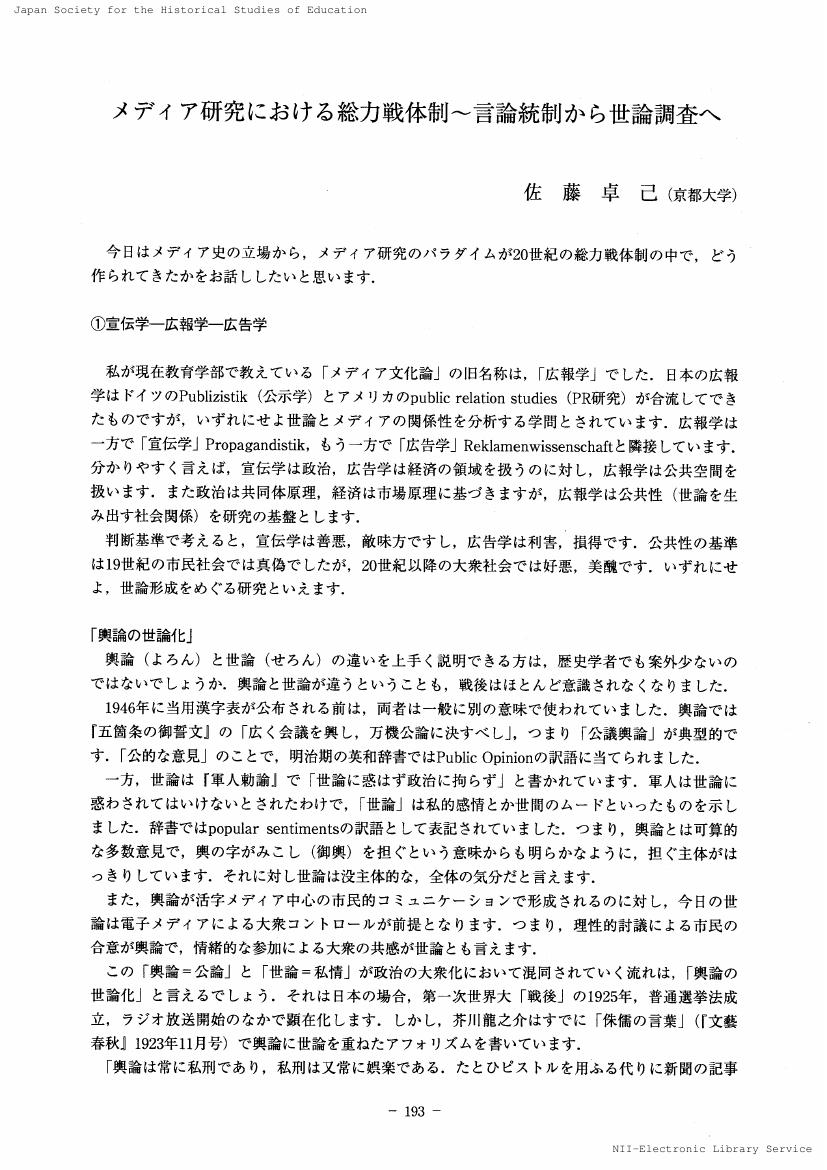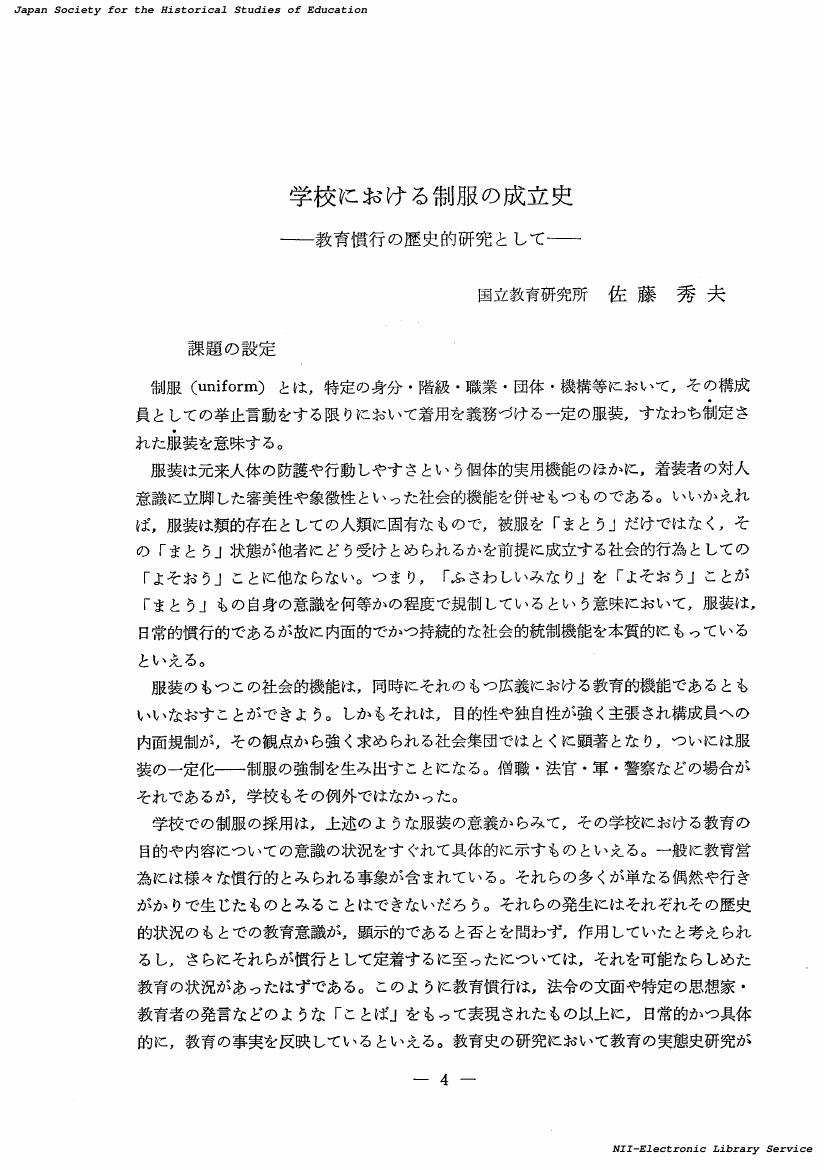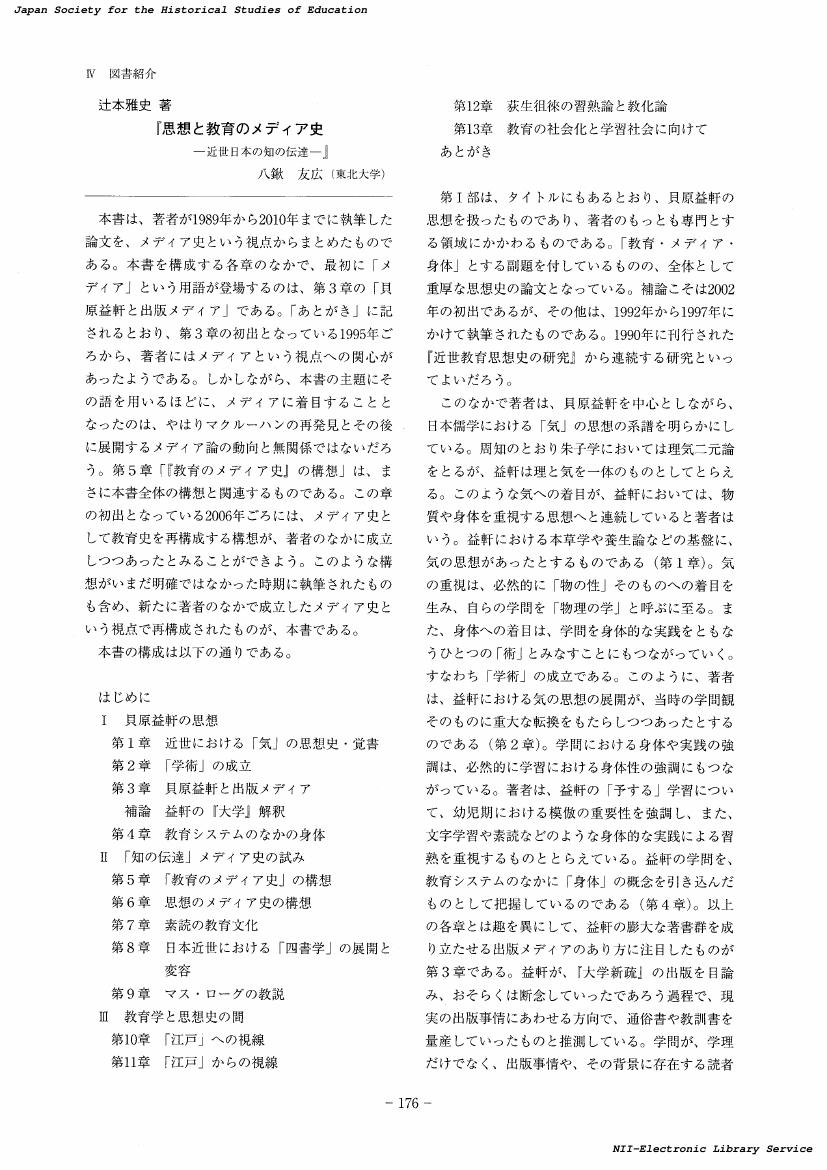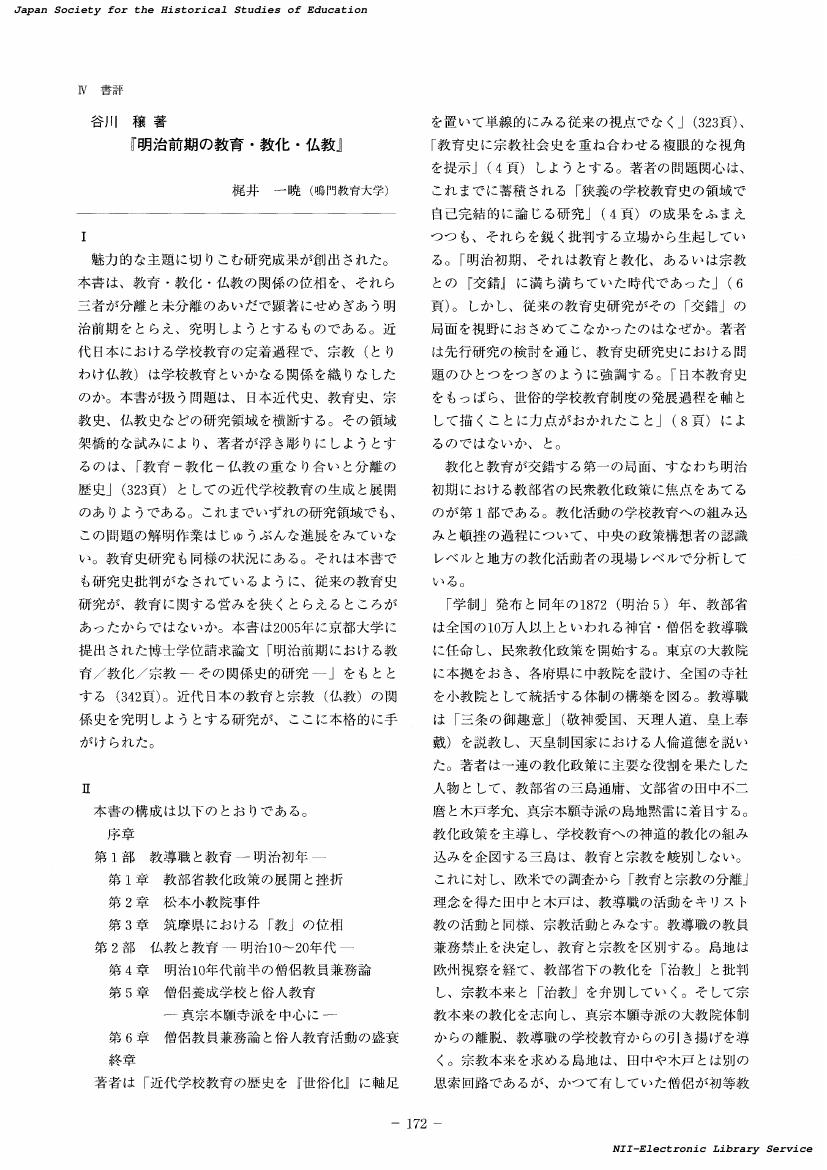1 0 0 0 OA 女子教育史における夜間女学校 : 文化夜間女学校・扇町夜間女学校を中心として
- 著者
- 水野 真知子
- 出版者
- 教育史学会
- 雑誌
- 日本の教育史学 (ISSN:03868982)
- 巻号頁・発行日
- vol.35, pp.90-106, 1992-10-01 (Released:2017-06-01)
1 0 0 0 OA 学校無用論と教育運動 : 下中弥三郎と江渡狄嶺を中心に
- 著者
- 三原 容子
- 出版者
- 教育史学会
- 雑誌
- 日本の教育史学 (ISSN:03868982)
- 巻号頁・発行日
- vol.34, pp.111-125, 1991-10-01 (Released:2017-06-01)
- 著者
- 佐藤 卓己
- 出版者
- 教育史学会
- 雑誌
- 日本の教育史学 (ISSN:03868982)
- 巻号頁・発行日
- vol.49, pp.193-198, 2006-10-01 (Released:2017-06-01)
- 著者
- 米田 俊彦
- 出版者
- 教育史学会
- 雑誌
- 日本の教育史学 (ISSN:03868982)
- 巻号頁・発行日
- vol.64, pp.126-130, 2021 (Released:2022-04-01)
1 0 0 0 OA 学校における制服の成立史 : 教育慣行の歴史的研究として
- 著者
- 佐藤 秀夫
- 出版者
- 教育史学会
- 雑誌
- 日本の教育史学 (ISSN:03868982)
- 巻号頁・発行日
- vol.19, pp.4-24, 1976-10-05 (Released:2017-06-01)
- 被引用文献数
- 2
- 著者
- 田代 美江子
- 出版者
- 教育史学会
- 雑誌
- 日本の教育史学 (ISSN:03868982)
- 巻号頁・発行日
- vol.52, pp.17-29, 2009-10-01 (Released:2017-06-01)
The purpose of this study is to analyze characteristics of the translated version of sexual education books published between 1910-1940. This paper clarifies the commonalities and differences of these publications with contemporary Japanese sexual education theories. At that time, there were many books on sexual education published in Japan. Japanese sexual education theories developed under the influence of European and American culture. A comparison of translated works and Japanese theories clarifies certain characteristics of Japanese sexual education theories. This approach will provide a better understanding of the essence of problems underlying current sexual education in Japan, a significant point of this study. Three characteristics of Japanese sexual education theories are delineated in chapter one: (1) Japanese sexual education began as sexual desire education; (2) the reason for the publication of so many books arose from a sense of impending crisis in the context of sexuality; (3) in spite of an increase in sexual education discussion, the educational field took an extremely negative attitude toward sexual education. Chapter two details U.K. and American attitudes toward sexual education as background to the translations of English works on the subject. In addition, the translated versions of sexual education theories are arranged in order of author's standpoint. Chapter three analyzes the contents of the translations from the following two perspectives. First, how the translations view the necessity and purpose of sexual education. Second, how human beings, sex differences, and gender roles became the premise of these sexual education theories. The first characteristic of the translations is that they strongly emphasize "the bad influence of the negative image of sex," and that an important purpose of sexual education was to wipe out this negative image. Accordingly, scientific knowledge of nature and sexual facts were regarded as important. There were even examples of how masturbation and homosexuality were addressed in a positive context Furthermore, some influence of First-Wave Feminism can be discerned, while conservative gender biases, such as "a man is active and a woman is passive" in sexual behavior, is strongly represented in the translations. Finally, differences between Japanese and translated versions of sexual education theories are analyzed. The three following differences are made clear. (1) In the translations, the most important purpose of sexual education is to promote an affirmative understanding of sex. In contrast, Japanese sexual education theories lacked such purpose. (2) In the translations, sexual morality means "positive sexual behavior and a sense of values." In the Japanese context, however, it means "abstinence." (3) The viewpoint of gender equality, readily found in the translations, is weak in the Japanese theories. These issues have direct bearing on today's problems in Japanese sexual education.
1 0 0 0 OA 三重県阿山高等公民学校の発足
- 著者
- 杉浦 由香里
- 出版者
- 教育史学会
- 雑誌
- 日本の教育史学 (ISSN:03868982)
- 巻号頁・発行日
- vol.58, pp.45-57, 2015 (Released:2016-05-02)
- 参考文献数
- 4
This research analyzes the establishment and management of Vocational Supplementary School in Ayama County, Mie Prefecture, which was founded in 1928 by a school cooperative of Ota Village and nine other villages. In the wake of local demand for educating candidates for middle-ranking managers who could be future leaders in the farm villages, the school was established as a daytime and year-round agricultural supplementary school for students who graduated from higher elementary schools. The school had its independent buildings, farm land, and athletic field, rare for a vocational supplementary school. It placed emphasis on vocational training based on the concept of “learning through doing.” Ota Village played a central role in establishing the school, and Mie Prefecture’s agricultural experiment station was involved in its management. However, the school was unable to gather as many students as it expected because there were many post-elementary institutions nearby, including Ueno Middle School. For this reason, there was a disconnect between the initial intention of school founders and what local students wanted to pursue. Not only that, an imbalance in student numbers within the village cooperative eventually created problems in managing the school cooperative.
- 著者
- 三橋 広夫
- 出版者
- 教育史学会
- 雑誌
- 日本の教育史学 (ISSN:03868982)
- 巻号頁・発行日
- vol.61, pp.158-159, 2018
1 0 0 0 OA 融和教育の一側面 : 内部児童カルト論の検討
- 著者
- 伊藤 悦子
- 出版者
- 教育史学会
- 雑誌
- 日本の教育史学 (ISSN:03868982)
- 巻号頁・発行日
- vol.34, pp.141-155, 1991-10-01 (Released:2017-06-01)
- 著者
- 三上 敦史
- 出版者
- 教育史学会
- 雑誌
- 日本の教育史学 (ISSN:03868982)
- 巻号頁・発行日
- vol.55, pp.58-71, 2012-10-01 (Released:2017-06-01)
This research is a historical survey of 16 student organizations, such as "Tokyo University Correspondence Society," that conducted "Academic Competition." These competitions were essentially trial examinations for students of high schools and preparatory schools (private schools for students preparing for university entrance examinations) all over the country. Using university facilities, these student organizations were founded by students to address the problems of student poverty and at the same time to improve the academic achievement of high school students. In this time period, national universities did not properly publicize information regarding campus life. Instead, the universities relied on student organizations to disseminate such information to students and the public. For this reason, they were fostered by university authorities, and their activities were reported in the media. A study of the history of these organizations reveals the following three points: First, there was a dramatic change in the perception of student organizations over the time under consideration. Initially, student organizations were seen as addressing student poverty and improving academic achievement of high school students. Over time, however, these same organizations were thougut to only be taking money from students and worsening "examination hell." As the latter perception became predominant among the public, student organizations were dismantled by 1970. This trend reflects the impact of post-war reconstruction and rapid economic growth that led to a dramatic increase in the number of students seeking a university education. Second, dispite the external shock of entrance exam changes and negative popular preception, these student organizations continued their business as usual. Even as they were seen as money-making ventures, student organizations remained a vital source of information regarding university for entrance examinees and for high schools and preparatory schools. Third, the business model designed by student organizations was unique and innovative, so much so that after their dissolution, their role was inherited by a new entrance exam "industry." After a fouryear absence of practice exams specific to each university, in 1974 Kawaijuku founded "The Tokyo University Open." Thereafter, variations of this model multiplied, and Kawaijuku became nationally recognized and moved its operation to Tokyo in 1977. Kawaijuku's success launched the "preparatory schools war," that lasted until the late 1980s. In a sense, student organizations were the precursors of the "preparatory schools war."
1 0 0 0 江戸時代の体罰観・研究序説
- 著者
- 江森 一郎
- 出版者
- 教育史学会
- 雑誌
- 日本の教育史学 (ISSN:03868982)
- 巻号頁・発行日
- vol.27, pp.4-24, 1984
- 著者
- 矢鍬 友広
- 出版者
- 教育史学会
- 雑誌
- 日本の教育史学 (ISSN:03868982)
- 巻号頁・発行日
- vol.55, pp.176-178, 2012-10-01 (Released:2017-06-01)
- 著者
- 白岩 伸也
- 出版者
- 教育史学会
- 雑誌
- 日本の教育史学 (ISSN:03868982)
- 巻号頁・発行日
- vol.60, pp.45-57, 2017 (Released:2018-04-01)
- 参考文献数
- 15
After the Potsdam Declaration, the Japanese government had to decide on the treatment of former military educational institution graduates (hereinafter referred to graduates), while attempting to transform the country’s self-image from “Imperial Japan” to “Democratic Japan”. The Ministry of Education tried to transfer many graduates to other schools. However, various discussions over the measure developed. This paper clarifies the formation of the measures for graduates in early postwar Japan by focusing on the trend of “demilitarization” and “democratization” and its scope.In August 1945, the Ministry of Army and Navy began to negotiate with the Ministry of Education to transfer graduates to other schools. As a result, the Cabinet decided upon “preferential transfers” for graduates. However, when students started to criticize and CIE (Civil Information and Education Section) started to intervene, preferential transfers were abolished in November. “Restrictive transfers” that limited the number of graduates to ten percent of a school’s capacity was determined in February 1946. Nevertheless, opinions criticizing restrictive transfers or insisting upon the necessity of re-education appeared. In addition, the discrepancy between the text of the Constitution of Japan and the Fundamental Law of Education and the measures was pointed out.As described above, the measures were formed through “consultation” and “crossbreeding” with the Ministry of Army and Navy, the Ministry of Education, and CIE. The scope of “demilitarization” was interpreted differently by each organization, so that “demilitarization” and “democratization” developed a relationship of mutual conflict and reliance. It may be considered that the achievement of “demilitarization” and “democratization” was hindered, thus affecting later historical developments.
- 著者
- 白石 崇人
- 出版者
- 教育史学会
- 雑誌
- 日本の教育史学 (ISSN:03868982)
- 巻号頁・発行日
- vol.60, pp.19-31, 2017 (Released:2018-04-01)
- 参考文献数
- 21
The purpose of this paper is to shed light on the significance of education research by elementary school teachers in Japan from 1901 to 1903, through an analysis of Ōse Jintarō’s theory of pedagogy as a science and through activities of the Society for Pedagogy and Educational Methods.In Japan after 1897, why did action-training-research come to be emphasized in education research? Why was school teacher’s education research considered to be linked to pedagogy study? This paper focuses on Ōse’s theory and activities to answer these questions. The Society for Pedagogy and Educational Methods, formed in 1901, is an important resource that provides an understanding of the history and origins of school teacher’s education research. It is necessary to research Ōse’s theory as the basis for this research. How was Ōse’s theory related to the activities of school teachers’ education research and the Society of Pedagogy and Educational Methods?This paper reveals three facts. First, in order to establish pedagogy study as an independent science, Ōse separated research on educational methods from research on the purpose of education, defining teacher education research as educational methods research. Second, influenced by Ernst Meumann’s experimental pedogogy study, Ōse attempted to transform teachers into educational methods researchers. Ōse abandoned experimental psychological research methods. Third, Ōse established the Society for Pedagogy and Educational Methods in order to organize education scholars involved in Higher Normal School, Imperial University, and private schools for education research of pedagogy and educational methods.
- 著者
- 牧野 篤
- 出版者
- 教育史学会
- 雑誌
- 日本の教育史学 : 教育史学会紀要 (ISSN:03868982)
- 巻号頁・発行日
- vol.52, pp.192-195, 2009-10-01
- 著者
- 三上 敦史
- 出版者
- 教育史学会
- 雑誌
- 日本の教育史学 (ISSN:03868982)
- 巻号頁・発行日
- vol.55, pp.58-71, 2012
This research is a historical survey of 16 student organizations, such as "Tokyo University Correspondence Society," that conducted "Academic Competition." These competitions were essentially trial examinations for students of high schools and preparatory schools (private schools for students preparing for university entrance examinations) all over the country. Using university facilities, these student organizations were founded by students to address the problems of student poverty and at the same time to improve the academic achievement of high school students. In this time period, national universities did not properly publicize information regarding campus life. Instead, the universities relied on student organizations to disseminate such information to students and the public. For this reason, they were fostered by university authorities, and their activities were reported in the media. A study of the history of these organizations reveals the following three points: First, there was a dramatic change in the perception of student organizations over the time under consideration. Initially, student organizations were seen as addressing student poverty and improving academic achievement of high school students. Over time, however, these same organizations were thougut to only be taking money from students and worsening "examination hell." As the latter perception became predominant among the public, student organizations were dismantled by 1970. This trend reflects the impact of post-war reconstruction and rapid economic growth that led to a dramatic increase in the number of students seeking a university education. Second, dispite the external shock of entrance exam changes and negative popular preception, these student organizations continued their business as usual. Even as they were seen as money-making ventures, student organizations remained a vital source of information regarding university for entrance examinees and for high schools and preparatory schools. Third, the business model designed by student organizations was unique and innovative, so much so that after their dissolution, their role was inherited by a new entrance exam "industry." After a fouryear absence of practice exams specific to each university, in 1974 Kawaijuku founded "The Tokyo University Open." Thereafter, variations of this model multiplied, and Kawaijuku became nationally recognized and moved its operation to Tokyo in 1977. Kawaijuku's success launched the "preparatory schools war," that lasted until the late 1980s. In a sense, student organizations were the precursors of the "preparatory schools war."
- 著者
- 梶井 一暁
- 出版者
- 教育史学会
- 雑誌
- 日本の教育史学 (ISSN:03868982)
- 巻号頁・発行日
- vol.52, pp.172-174, 2009-10-01 (Released:2017-06-01)
- 著者
- 井上 薫
- 出版者
- 教育史学会
- 雑誌
- 日本の教育史学 (ISSN:03868982)
- 巻号頁・発行日
- vol.58, pp.165-167, 2015
1 0 0 0 OA 礼記に見る教育の目的及び教育の方法論 : 大学・中庸・学記を中心として
- 著者
- 洪 祖顕
- 出版者
- 教育史学会
- 雑誌
- 日本の教育史学 (ISSN:03868982)
- 巻号頁・発行日
- vol.14, pp.112-129, 1971-10-05 (Released:2017-06-01)
1 0 0 0 IR 自衛隊生徒の発足 : 1955年の少年兵
- 著者
- 逸見 勝亮
- 出版者
- 教育史学会
- 雑誌
- 日本の教育史学 (ISSN:03868982)
- 巻号頁・発行日
- vol.45, pp.162-180, 2002
